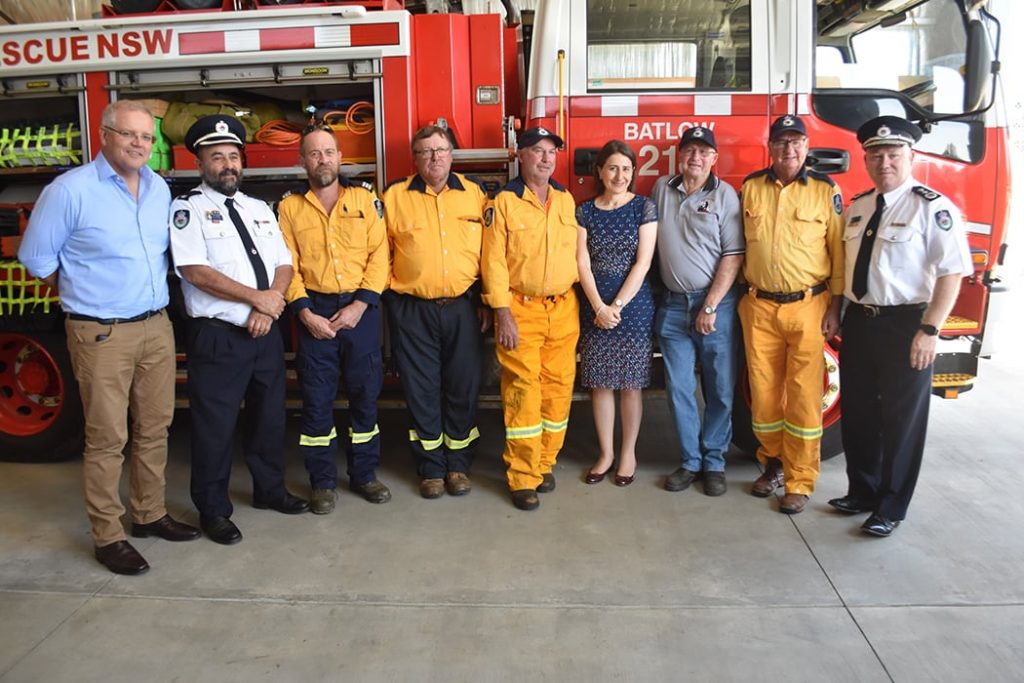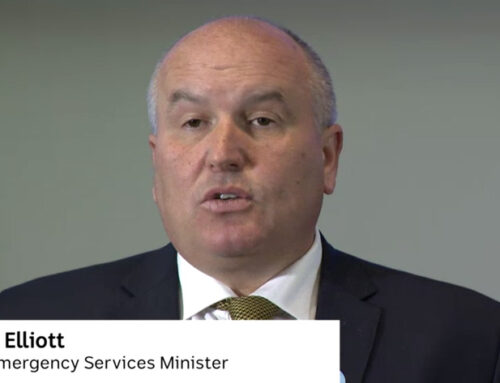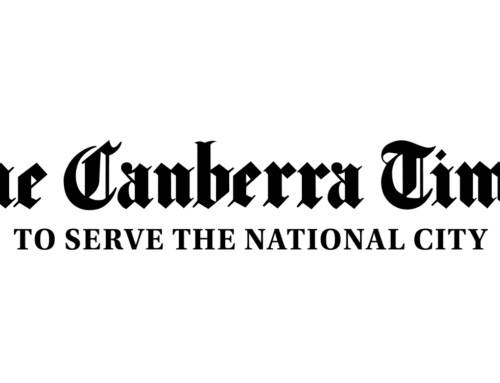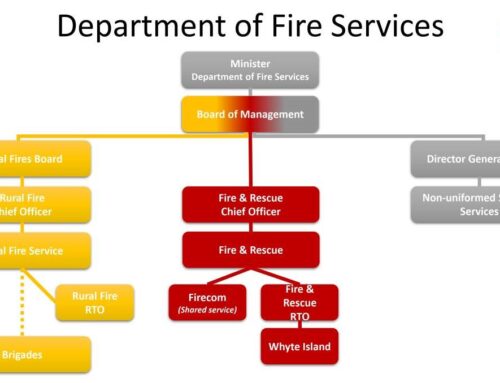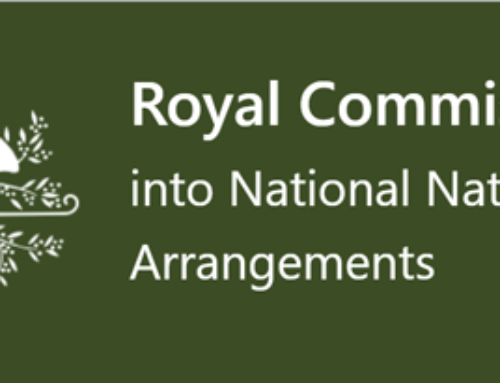As a host of high profile politicians poured into the Snowy Valleys earlier this week, it was someone else who stole the limelight and often the hearts of those he spoke to.
Every morning, NSW Rural Fire Service (RFS) Commissioner Shane Fitzsimmons addresses the state, updating its residents on the current fire situations and informing them on what to expect over the next 24 hours.
For the several thousands evacuated from the Snowy Valleys at the start of the year, he began to become their go-to guy and the empathy and careful consideration with which he spoke offered some sort of reassurance even on the most testing of days.
Mr Fitzsimmons was welcomed with open arms when he visited Batlow and fire-affected farms before attending a community barbecue held at the Tumbarumba Creekscape on Wednesday.
He mingled with those in attendance and whilst his primary aim was to thank those involved in battling the blazes, he was often the one who received praise from thankful community members who were pleased to see his now familiar face.
Mr Fitzsimmons said he was proud and impressed with the response from the Snowy Valleys community following the horrific Dunns Road fire.
“You have got this extraordinary workforce that is the frontline firefighters, the volunteers, the salary firefighters, Fire and Rescue, National Parks, Forestry, RFS. Then you have got the police and emergency services, but they aren’t the only effort,” Mr Fitzsimmons said.
“You have got the community members, the farmers, the landowners, the people in town. The way they all came together, the way they’ve worked together, listened to advice, making considered decisions.
“The amount of people I have spoken to this morning that said look, we got the warnings, we weren’t in a position to do anything, we got out; we made sure we made a conscious decision.
“Other people said, I knew it was coming, I was getting good advice, I was ready, I was prepared and I did my thing.
“Some of the farms we have visited, they have saved all of the buildings. Yes they’ve lost feed, they’ve lost paddocks, they’ve lost fences, but their livestock’s alive and yeah they’ve got some damaged orchards, but in the main, they have been quite remarkable and we owe a debt of gratitude to everybody who did their bit in what was truly a horrendous situation.”
Mr Fitzsimmons saw some of the fodder drops in and around the region and paid credit to all those putting their hand up to help.
“It’s that spirit of renew, of rebuilding, of moving on, which is pretty powerful,” he said.
“What people have experienced through this part of NSW has really been a most traumatic set of circumstances, but you look at the community spirit that’s here today. You’ve got, not just the fire and emergency services people here, but you’ve got locals, you’ve got people from out of the area, you’ve got the ADF; that’s a pretty remarkable sign.”
With whole towns evacuated for a considerable period of time, residents were desperate to return home, however the majority chose to stay away until their town was deemed to be safe to return to.
Mr Fitzsimmons said this patience and understanding shown by the local communities was crucial.
“There was a tremendous amount of patience and understanding because no matter which road you drive around through these parts, you can see how dangerous the trees were, how dangerous the situation was, and we had to get those roads cleared, we had to get those roads made safe before we could let people get back in,” he said.
“A lot of the orchardists were saying, we want to get pickers back in to try to salvage what we can, but we don’t want to send people through and have some sort of awful injury from a falling tree. So the patience that people have displayed is quite remarkable and more than remarkable, its genuinely and sincerely appreciated because without that patience, without that tolerance and understanding, things could have been a whole lot worse.”
Mr Fitzsimmons described his drive through the Snowy Valleys as “heartbreaking” and said the devastating scenes reflected the stories and feedback that he had been hearing from people on the ground.
Flights he took over fire affected areas allowed him to see the true extent and scale of damage caused by these fires.
“You can see the extraordinary intensity that some of these fires have burnt, the volatility of the fire behaviour, the spread of the fire behaviour,” Mr Fitzsimmons said.
“In some areas the trees are completely denuded of all foliage of all vegetation; you’ve only got stands of timber and trunks.
“There are other areas where it is less intense, but it has still taken everything available off the floor so depending on the ferocity of the fire and talking to land holders, the amount of ember activity that was landing in and around their property, it wasn’t just the main fire front that was bearing down on them, it was raining embers and embers were just starting dozens and dozens of new fires all around them.
“If anyone tells you that that’s not confronting, that’s not frightening, is not telling the truth.”
Mr Fitzsimmons had visited a local café for lunch before heading down to the barbecue and he emphasised the importance of getting people back visiting the region.
“Talking to the shop keepers, they know that tourism is down, they know people aren’t here, they get it, they understand, and they know that we are all trying to work to get people to come back and visit these areas,” he said.
“The community wants people to come back; the community’s not gone, the community’s not written off. Yes there’s some damage, yes there’s some despair, but there’s hope and there’s a want to move on and a want to rebuild and they can only rebuild if people are going to come back and spend their money and stay in town, eat at the local cafes and drink at the local pub.
“We really want people to get back into town.”
Mr Fitzsimmons said that the recent rain had been a welcome relief for firefighters with the much-needed rainfall making a big difference right across the region.
Despite this, he said it would not take much for things to turn around.
“We’re already seeing today (Wednesday), in Western NSW, temperatures right up into the low and mid forties. We have got winds up around 80, 90km/h and all that weather is going to start moving east tomorrow (Thursday) so we can expect widespread total fire bans in parts of NSW tomorrow,” he said.
“So whilst the rain has certainly been welcome, it’s provided reprieve, we have still got to get through the rest of summer, we’ve still got to get through the rest of this fire season, so we cant afford for people to be complacent.”
Although there is no immediate threat from the Dunns Road fire to the Snowy Valleys, the blaze does remain active in higher mountain areas.
Remote area firefighter specialists have been inserted into some of these rugged, difficult-to-access fire areas.
“These specialists are hard at work at the moment while the conditions are more benign,” Mr Fitzsimmons said.
“A lot of work is really focussed at the moment on establishing and consolidating containment lines.
“We will continue to build those fall back lines in case we see new flare and new activity, but of course we have still got lots of aircraft, heavy machinery and firefighters positioned ready to go should we see any new fires or any outbreaks from the current fires.”
Crews from the United States, Canada and New Zealand who were brought in to assist with the bushfires remain here on the ground, however those from America and Canada are expected to return home this weekend. Arrangements do however remain in place should more assistance need to be activated and accessed over the coming months.
Mr Fitzsimmons praised the camaraderie shown by all the crews that have been brought together to tackle the crisis.
“What a wonderful addition to the workforce they’ve been,” he said.
“Not only have they provided us relief and rest for some of our members, but they have increased the numbers and they have brought with them a wealth of expertise, a wealth of experience, lots of wisdom and they’ve seamlessly integrated into the local management teams.
“It’s great to wander into the Tumut centre or even just over the other side of Cooma, or wherever we have been right across NSW, and to see that international camaraderie, but to see it seamlessly working so well speaks volumes of what we have learnt over the decades and of our national standards and our international standards. To provide that integration is fantastic.”
Kayley Dickinson

